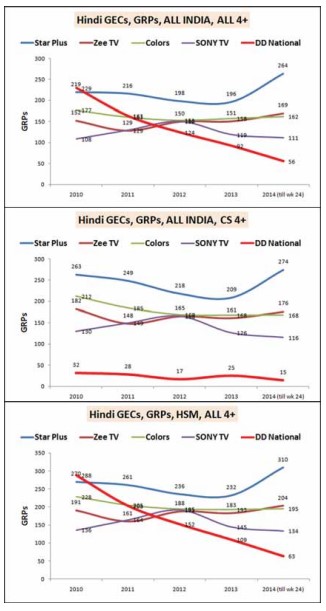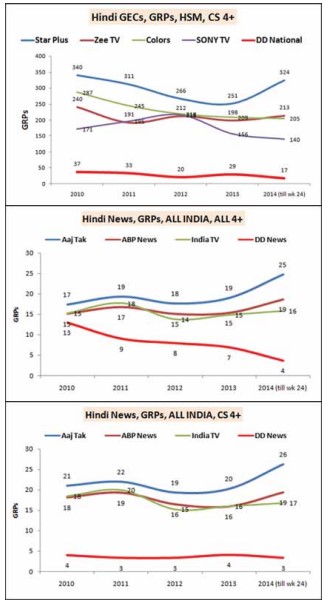My interactions with Doordarshan started back in 1989, almost 25 years ago. I was a Senior Media Planner with Mudra Communications and it was imperative for planners to be oriented with all the operational aspects of media. Hence, I was put under the stewardship of the Media Controller, DD, R Nair, in this case. Nair was a man of few words and was very caustic in his behaviour. He had a very cut-and-dry approach and was generally not welcome in social gatherings of the agency. One day, over a spirit beverage, he opened up with me. He said, “The main reason I am like this is because of my dealings with Doordarshan and its people.” I never understood, till the time he took me to Mandi House to meet all the people connected with advertising and marketing. They had dull and sullen faces, not pleasant and not happy at meeting someone for the first time. In fact, they were reticent and senile in their conversations.
There was little that anyone in an advertising agency could do, as Doordarshan in those days was indispensable to the media plan; clients would do anything to be on the right side of this gigantic medium. The halo of Doordarshan was set up by the iconic serials it created in the form of Buniyaad and Hum Log. Bharat Ek Khoj by Shyam Benegal was another feather in Doordarshan’s cap.
Festivity and Doordarshan
Deepawali was approaching and there was paranoia all over. I did not understand the concern, the fear and the anxiety. For me, Deepawali was all about celebrations till I was told that the anxiety was about what to present to Doordarshan officials as gifts this Deepawali. Each level had to be treated separately and the gifts had to stand out from those of other agencies. It was tough, but then mental faculties from different walks of life finally agreed on all gifts of different value for different levels of officers. This important bequeathing had a major role in the way we were treated by Doordarshan in the coming year.
This behaviour and attitude continued from both sides. There was power and attitude on one side and restlessness and helplessness on the other. This was the start of the erosion of the media powerhouse called Doordarshan.
Early 1990s
Doordarshan had the top programmes in the form of Chitrahaar and the Hindi feature film on a national footprint, and the same format was followed across the regional LPTs. Each State had its own film industry which had the maximum eyeballs. Doordarshan had the complete domination of the audio-visual media market. Each top programme was watched by more than half the country—that is, the TRP was greater than 50 per cent. Currently, DD’s top rated programme nationally is under 5 per cent. That was the scale and popularity of Doordarshan programmes.

The Nestle story
Doordarshan was high-handed in its approach in the late 1980s and the early 1990s. When I was a Media Planner in Mudra Communications, some clerk at the Controller of Sales office at Mandi House made a mistake in the scheduling of spots in the Tamil feature film in the Madras LPT for the Tamil Nadu market. The plan had initially one spot of ‘Nesfit’ in each ad break and there were four ad breaks. However, when the schedule was released by DD Delhi, it had two spots of 30 seconds each in each of the ad breaks. As a result, Nestle had to pay double than what they had planned. DD’s explanation was: It was a mistake, but Nestle better pay up or face the consequences in future. This was a helpless time for the agency as we could not go to the client and say this was a blunder committed by DD. Such instances the aggrieved party would never forget in the future, and they would come to be the curse for DD in times to come.
Saddam to the rescue
Then came 1991 and Iraq invaded Kuwait. This was a blessing in disguise for all private satellite channels as, one by one, all started relaying into Indian homes. This invasion was to be a big curse for Doordarshan and its high handedness. Along with CNN and BBC, entertainment channels beamed into India. Slowly, the Star network, the Sony Network and the Zee network started entertaining homes in the metros and big cities via the cable and satellite transmission system. In the next 10 years, by early 2000, there were close to 50 million cable and satellite TV homes in the urban market.
But through the 1990s, DD still was a force to reckon with and still was the only authority to certify storyboards for a commercial film. This meant that if a 30-second spot had to run on Star Plus or Sony, it had to be cleared by the Controller of Sales at DD. This new-found power and control over all private satellite channels went to the head of DD officials: they became even more difficult to handle.

First private news channel
DD never realised the strength it had. It seldom acknowledged the quality of content created by its producers. In the late 1990s, Surendra Pratap Singh, an eminent journalist, used to anchor and produce a programme called Aaj Tak on DD Metro. It was a half-an-hour current affairs show and focused on the concerns of society. It soon became a rage and SP—as he was known—became a household name. SP became the guardian of the deprived sections of society. He used to get thousands of letters every week and this was the first cut in selecting stories.
Aaj Tak was soon off Doordarshan and was launched as a private news channel by the same name, owned by the Living Media Group. I was in TBWA at that time and had worked on the business pitch for Aaj Tak and won it. The channel was the first one to bring agility into news delivery as its basic propositio—it was “Sabse Tez”. This was a jewel of Doordarshan that was bequeathed to the private corporate world.
The early 2000s
The new century saw the emergence of a new Director-General. I think it was 2003 or 2004. Dr SY Quraishi had taken over Doordarshan operations as Director-General. He tried connecting with the corporate world for ideas that could leverage DD to the next level. This was the time when all private satellite networks had pressed the accelerator and were cruising in terms of generating higher revenues year on year. The main ones were the Star network, the Sony network and the Zee network.
Seeking a pitch
 One of the firsts was to call the leading advertising agencies of India to Mandi House for a communication briefing. This surprised many as DD was always seen as operating alone and setting the rules. DD never asked anyone for advice, leave alone a private advertising agency. In the advertising agencies, the less able and the less charismatic persons were designated to deal with DD officials. The reason was simple: one needed a very different kind of skill-set to handle DD officials, the main ones being patience, persistence and perseverance.
One of the firsts was to call the leading advertising agencies of India to Mandi House for a communication briefing. This surprised many as DD was always seen as operating alone and setting the rules. DD never asked anyone for advice, leave alone a private advertising agency. In the advertising agencies, the less able and the less charismatic persons were designated to deal with DD officials. The reason was simple: one needed a very different kind of skill-set to handle DD officials, the main ones being patience, persistence and perseverance.
I represented one of the agencies which were invited, TBWA. I was given charge to lead the pitch and go for the briefing with my team.
The Briefing
The briefing was a shock to me. Eighteen advertising agencies were huddled onto the fifth floor conference room at Mandi House and asked to wait. This was a surprise as the norm was to brief one agency at a time so that the concerned agency could also react to the brief and come back for a final presentation. However, this was DD. After a 30-minute wait, Dr Quraishi emerged and stated his vision for DD. He asked all agencies to put in their strategic best and then outline a financial proposal for handling the 29 DD channels. The task clearly was how to highlight the strengths of Doordarshan and how to ensure lesser erosion of revenue going to the private satellite channels. All agencies submitted their presentations in the next four weeks and the winners were announced as JWT and TBWA. The two agencies were given different roles. My role was to highlight the strengths of DD and its channels and to enhance the revenues which were sluggish in growth, year on year.


A new expert panel committee
Dr Quraishi focused on quality content. To ensure this, he constituted an expert panel committee of the government and private professionals from the world of advertising, marketing and media. I was fortunate to be on one of them. We used to meet once a month at Mandi House and view all content, debate and then decide what to air.

The big idea
During this time, I looked at all research numbers from TAM Nielsen— Indian Readership Survey—to decide what stories to give the advertiser. We had close to 50 million satellite television homes and over 118 million DD homes. My idea was to focus on the homes that did not have a cable connection and also look at their profile in terms of consumption, education and lifestyle. This made us realise that we were sitting on a gold mine. DD was still ruling the air waves. So we decided on the line, “The market all satellite channels put together cannot give you.” Mailers and advertising pitch targeting the advertisers stated: “Can you afford to ignore this market?” Dr Quraishi loved this idea and felt that we should present it to the big advertisers in Mumbai before we launched the advertising campaign on television and in print.

The big presentation
I went to Mumbai with Dr Quraishi and gave a presentation to the Indian Society of Advertisers and the Advertising Agencies Association. We went category by category and the response was breathtaking. We, at the agency and at DD, were all excited to launch the big campaign. But, the campaign on TV and mainline dailies never saw the light of day. We could not figure out why. Slowly, over the years, the cable and satellite households grew along with the DTH households. Collectively, they sealed the fate of DD and its channels.
What now?
All is not lost even now, as DD still has quality programmes and a strong news desk. The quality of news is good whereas in all private news channels it has become more of noise and less of news.
I also do not understand the role and relevance of Lok Sabha and Rajya Sabha TV channels running separately. However, these are some aspects that the management of Prasar Bharati could consider:
• Like any other marketing professional, I am a strong believer that a programme on TV is as good as other programmes going on at that particular time on other channels. This reality of competition needs to dawn on the creators of programmes in DD. Currently, they seem to be operating in isolation.
• DD needs a strong marketing department of skilled professionals, who can market its content to advertisers. It needs a strong pro-active audience research cell that can track the pulse of the changing audience and its preferences. The head of this research cell needs to advise the editorial team on fine-tuning of its programming.
• DD needs to make its programming more interactive so that it can create a community of its own and build bonds with them. Currently, these aspects are lacking as no bureaucrat has ever been made accountable to a balance sheet and financial realities. The reality is that he is transferred in three years and a new bureaucrat comes to start things afresh. This is the biggest challenge for a social broadcaster and has been the biggest plus for private channels.

The earlier we correct this notion that “a social broadcaster does not need to have a profit motive”, the better. To me, this attitude is an excuse for non-delivery and poor performance. Being a social broadcaster does not mean that it should be foolish enough to lack mental faculties and business acumen. More so, for the good cause of healthy revenue. Armchair allocations to private producers for a fee is a thing of the past. This suits private producers and not Doordarshan.
We are now in a world where government-private partnerships are a norm. The Prasar Bharati Board should hire a professional team and make it accountable. A rough assessment tells me that in three years, DD should be clocking at least close to Rs. 6,000 crore in advertising revenues. Currently, it’s a fraction of that amount—that’s the market it is missing out on without sacrificing its social objectives.
If we can make these small changes and understand that a metamorphosis is inevitable, I am sure we can get back the glory of a media powerhouse called Doordarshan.
The writer is Business Adviser, Melon Media




























































